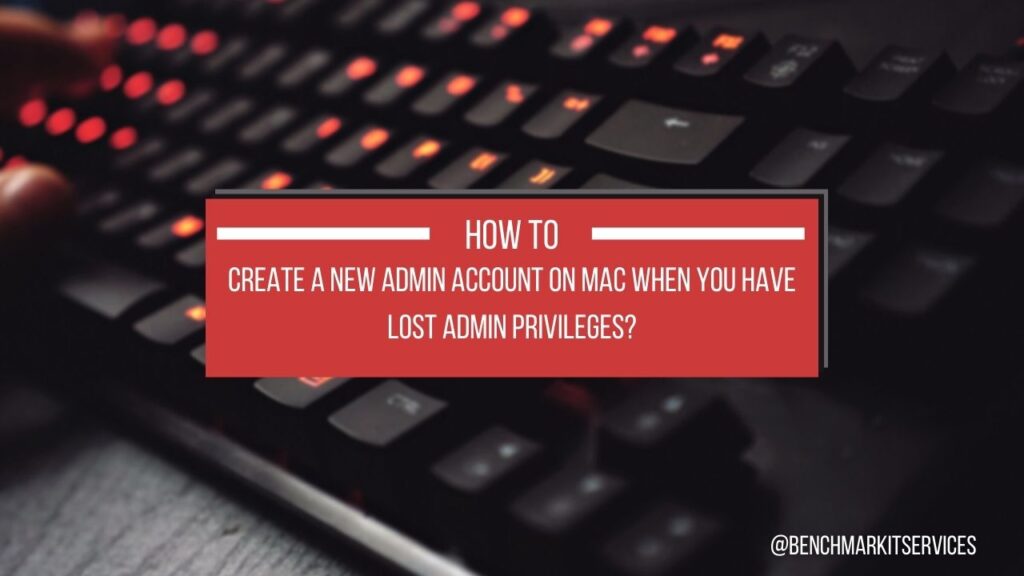If your Mac doesn’t have an administrator account or if your Mac account has lost its admin privileges, you can always recover the admin rights of the macOS quickly by following these steps:
You can create a new admin account with the help of Apple’s Setup Assistant tool. To set up this process, you should remove the file “.AppleSetupDone” by accessing the Terminal or macOS Recovery mode. It can create the admin account in Single user and multi-user modes.
1. To create an Admin in Single user mode:
Step 1: Start by Turning off your Mac.
Step 2: You will need to boot the Mac to the single-user mode by pressing Command + S immediately after turning on the Mac. This will boot the Mac into single-user mode.
Step 3: The Mac boots up, displaying lines of code scrolling on the screen. Once the screen stops, you -will find :/ Root # on the command line prompt.
Step 4: You need to mount the startup drive to access files. It is not mounted by default. Type /sbin/mount -UW / and press Enter on the keyboard. This will mount the startup drive.
Step 5: Now, enter rm /var/DB/.applesetupdone and press Enter. This command makes the system think that the Mac is booting up for the first time and will let you create a new administrator account. Please note that this will not make any changes to the existing system or the user files. It just lets you create another new administrator account.
Step 6: Now type reboot and press Enter. Since the applesetupdone file is removed, the Mac will display the “Welcome to Mac” screen.
You can create a new admin account by following the step-by-step setup prompts.
Step 7: Now, select “Language” and click on Continue.
Step 8: Choose your “Country” and select Continue.
Step 9: Set up the “Keyboard” settings and click on Continue.
Step 10: Set up c;o and establish the Wi-Fi network on the Mac.
Step 11: On the next screen, the Mac will display “Transfer information to this Mac”. You can tick and mark the appropriate box to initiate a transfer. You can also choose not to transfer any data.
Step 12: Now, Mac will ask to “Sign in with your Apple ID”, or you can click “Don’t Sign In” to skip this step or set it up later.
Step 13: Agree to “Terms & Conditions” to proceed further.
Step 14: Enter the following user details to create a new Admin Account on Mac and click on Continue.
Step 15: To set up the Mac on “Express Setup Screen”, click on Continue.
Step 16: Go to the Apple menu – System Preferences – User & Groups.
Step 17: To change the admin privileges of Standard User, click on the “Lock” icon and type in the password. This will unlock the user settings.
Step 18: Now, you can change the standard user account to an Administrator account, then click on “Allow user to administer this computer”.
Now, a new user has been created with admin privileges using a mac terminal (single-user mode).
You can delete the newly created Administrator user or keep it as a backup account.
2. To create an Admin in Multiple user mode when there is no admin account:
Step 1: Turn off your Mac.
Step 2: You will need to boot the Mac to recovery mode by pressing Command + R immediately after turning on the Mac. This will boot the Mac into recovery mode.
Step 3: The Mac boots up the terminal.
Step 4: At the command line, type cd /Volumes/”Macintosh HD”/var/DB (Generally, the Volume name is “Macintosh HD”, but it changes as per the complex disk model. In our case, it is “WD240GB SSD” ) and press Enter on the keyboard.
Step 5: At the CLI, type the command ls -la (Mac will list all the files, you should now see a file named .AppleSetupDone)
Step 5: Enter rm.AppleSetupDone and press Enter. This command will let you create a new administrator account. Note that this will not make any changes to the existing system or user files.
Step 6: Now type reboot and press Enter. Since the applesetupdone file is removed, the Mac will display the “Welcome to Mac” screen.
You can create a new admin account by following the step-by-step setup prompts.
Step 7: Now, select “Language” and click on Continue.
Step 8: Choose your “Country” and like Continue.
Step 9: Set up the “Keyboard” settings and click on Continue.
Step 10: Set up and establish the Wi-Fi network on the Mac.
Step 11: On the next screen, the Mac will display “Transfer information to this Mac”. You can tick and mark the appropriate box to initiate a transfer. You can also choose not to transfer any data.
Step 12: Now, Mac will ask to “Sign in with your Apple ID”, or you can click “Don’t Sign In” to skip this step or set it up later.
Step 13: Agree to “Terms & Conditions” to proceed further.
Step 14: Enter the following user details to create a new Admin Account on Mac and click on Continue.
Step 15: To set up the Mac on “Express Setup Screen”, click on Continue.
Step 16: Go to the Apple menu – System Preferences – User & Groups.
Step 17: To change the admin privileges of Standard User, click on the “Lock” icon and type in the password. This will unlock the user settings.
Step 18: Now, you can change the standard user account to an Administrator account, then click on “Allow user to administer this computer”.
Now, a new user has been created with admin privileges using a mac terminal (multi-user mode)
You can delete the newly created Administrator user or keep it as a backup account.
For any personal or business-related IT support services, please visit https://www.benchmarkitservices.com.au.
For general support issues of home users: https://www.computerepaironsite.com.au/

